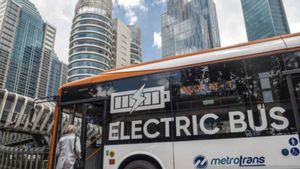JAKARTA - On December 1, 1955, Rosa Parks was jailed for refusing to give her seat on a bus to a white man. This is a violation of the racial segregation laws on buses in Montgomery, Alabama, United States (US).
The imprisonment of Rosa Parks prompted a Montgomery bus boycott movement organized by a pastor named Martin Luther King, Jr. The bus boycott movement is also considered the event that started the National Civil Rights Movement.
According to History, according to the Montgomery City ordinance in 1955, African Americans were required to sit in the back of the bus and were required to give up the seat to whites if the front of the bus was full. At that time Parks was in the first row of the section for African Americans.
The white bus driver asked Parks to give his seat to a standing white male passenger. The regulations do not specifically give bus drivers the power to demand that passengers give up seats to anyone, regardless of race.

However, Montgomery bus drivers are used to making black and white passenger marks. Because of this, drivers often ask black passengers to give up their seats to white passengers.
If black passengers protest, the bus driver has the authority to refuse service and can call the police to remove them. The other three black passengers on the bus complied with the driver's request. but Parks refused and remained seated.
The driver asked, "Why don't you stand up?" Parks replied, "I don't think I should stand up."
The driver called the police, who then arrested Parks. Some popular stories say Parks refused to give up his seat because he was tired.
In fact, however, civil rights advocates had plotted against Montgomery's racial segregation laws. Parks had been privy to this discussion.
Protests are widespread
Learning of Parks' arrest, The National Association for the Advancement of Colored People (NAACP) and other African-American activists immediately called for a bus boycott. The black boycott began on Monday 5 December 1955.
News was spread through leaflets and activists formed the Montgomery Improvement Association to organize the protests. The first day of the bus boycott was a huge success.
However, Martin Luther King, Jr., as the leader of the bus boycott received many death threats from these opponents. His house was bombed. But he and his family escaped physical injury.
The boycott lasted for more than a year. People who participate in boycotts choose to take their private cars or walk the kilometers to work and school.
Since African Americans made up 70 percent of the Montgomery bus passengers, the city's transit system suffered greatly during the boycott. On November 13, 1956, the U.S. Supreme Court repealed the racial segregation laws on city buses in the states of Alabama and Montgomery.

This is because it was proven to violate the protection clause of the 14th Amendment to the US Constitution. "The year-long protests against city buses are officially stopped and Negroes in Montgomery are urged to return to buses tomorrow morning separately."
After the boycott ended, Rosa Parks was the first to board the desegregated bus. Martin Luther King, Jr., and his nonviolent civil rights movement had their first major victory.
The boycott prompted many activists to launch a movement to eliminate racial injustice. Rosa Parks died on October 24, 2005. Three days later the US Senate passed a resolution honoring Parks by allowing Parks' body to be buried in the Capitol Rotunda.
*Read other information about WORLD HISTORY or read other interesting articles from Putri Ainur Islam.
TODAY'S HISTORY MoreThe English, Chinese, Japanese, Arabic, and French versions are automatically generated by the AI. So there may still be inaccuracies in translating, please always see Indonesian as our main language. (system supported by DigitalSiber.id)









